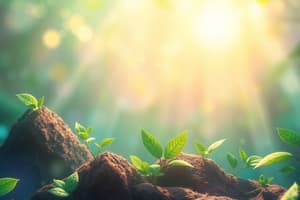Podcast
Questions and Answers
What is the primary function of photosynthesis?
What is the primary function of photosynthesis?
- To convert glucose into energy
- To release oxygen
- To produce food for other organisms (correct)
- To absorb carbon dioxide
Photosynthesis is an exergonic process.
Photosynthesis is an exergonic process.
False (B)
What is the role of chlorophyll in photosynthesis?
What is the role of chlorophyll in photosynthesis?
Chlorophyll absorbs photons and captures light energy.
The primary photosynthetic pigment is called _____
The primary photosynthetic pigment is called _____
Match the type of light interaction with its description:
Match the type of light interaction with its description:
Which of the following best describes the wavelengths of light that drive photosynthesis?
Which of the following best describes the wavelengths of light that drive photosynthesis?
Chlorophyll molecules are located in the thylakoid membranes.
Chlorophyll molecules are located in the thylakoid membranes.
Which atom is centrally located in the chlorophyll molecule?
Which atom is centrally located in the chlorophyll molecule?
What is produced during the light-dependent reactions of photosynthesis?
What is produced during the light-dependent reactions of photosynthesis?
The light-independent reactions occur in the thylakoid membranes of chloroplasts.
The light-independent reactions occur in the thylakoid membranes of chloroplasts.
What light colors does chlorophyll a primarily absorb?
What light colors does chlorophyll a primarily absorb?
What are the two types of chlorophyll involved in photosystems I and II?
What are the two types of chlorophyll involved in photosystems I and II?
Chlorophyll b is more abundant than chlorophyll a in green leaves.
Chlorophyll b is more abundant than chlorophyll a in green leaves.
What happens to chlorophyll when it absorbs a photon?
What happens to chlorophyll when it absorbs a photon?
The primary electron acceptor in photosynthesis is abbreviated as _____ .
The primary electron acceptor in photosynthesis is abbreviated as _____ .
The pigments that give brown colors to leaves are called __________.
The pigments that give brown colors to leaves are called __________.
Which chlorophyll has a maximum absorbance at 700 nm?
Which chlorophyll has a maximum absorbance at 700 nm?
Match each photosystem with its maximum absorbance:
Match each photosystem with its maximum absorbance:
Match the following pigments with their corresponding features:
Match the following pigments with their corresponding features:
Which statement is true regarding accessory pigments?
Which statement is true regarding accessory pigments?
Carotenoids do not directly transfer their excited electrons to the primary electron acceptor.
Carotenoids do not directly transfer their excited electrons to the primary electron acceptor.
The process of generating ATP through the movement of protons across the ATP synthase complex is known as _____ .
The process of generating ATP through the movement of protons across the ATP synthase complex is known as _____ .
Photo-excitation results in electrons being permanently removed from chlorophyll.
Photo-excitation results in electrons being permanently removed from chlorophyll.
Name the two stages of photosynthesis.
Name the two stages of photosynthesis.
What are the main requirements for the light stage of photosynthesis?
What are the main requirements for the light stage of photosynthesis?
Chloroplasts have a less permeable outer membrane compared to their inner membrane.
Chloroplasts have a less permeable outer membrane compared to their inner membrane.
What is produced during the light stage of photosynthesis?
What is produced during the light stage of photosynthesis?
The inner membrane of the chloroplast surrounds a large space called the ______.
The inner membrane of the chloroplast surrounds a large space called the ______.
Match the following components of the dark stage with their functions:
Match the following components of the dark stage with their functions:
Flashcards
Photosynthesis
Photosynthesis
The process by which photosynthetic organisms use light energy to synthesize organic compounds, primarily glucose, from carbon dioxide and water.
Photosynthetic pigments
Photosynthetic pigments
Molecules that absorb specific wavelengths of light energy, crucial for photosynthesis.
Chlorophyll
Chlorophyll
The primary photosynthetic pigment in plants, responsible for absorbing red and blue light, and reflecting green light, which gives plants their color.
Chlorophyll a
Chlorophyll a
Signup and view all the flashcards
Chlorophyll b
Chlorophyll b
Signup and view all the flashcards
Carotenoids
Carotenoids
Signup and view all the flashcards
Thylakoid membrane
Thylakoid membrane
Signup and view all the flashcards
Visible light
Visible light
Signup and view all the flashcards
Chloroplast function
Chloroplast function
Signup and view all the flashcards
Chloroplast structure
Chloroplast structure
Signup and view all the flashcards
Light-dependent reactions
Light-dependent reactions
Signup and view all the flashcards
Chemiosmosis
Chemiosmosis
Signup and view all the flashcards
Light stage requirements
Light stage requirements
Signup and view all the flashcards
Accessory pigments
Accessory pigments
Signup and view all the flashcards
Photo-excitation
Photo-excitation
Signup and view all the flashcards
Photo-oxidation
Photo-oxidation
Signup and view all the flashcards
Tannins/Anthocyanins
Tannins/Anthocyanins
Signup and view all the flashcards
Photosystem
Photosystem
Signup and view all the flashcards
Photosystem II (PSII)
Photosystem II (PSII)
Signup and view all the flashcards
Photosystem I (PSI)
Photosystem I (PSI)
Signup and view all the flashcards
Primary Electron Acceptor (PEA)
Primary Electron Acceptor (PEA)
Signup and view all the flashcards
ATP
ATP
Signup and view all the flashcards
Study Notes
Capturing Solar Energy
- Photosynthesis is the process by which photosynthetic organisms capture sunlight to make food
- Sunlight provides the energy for photosynthesis
- Photosynthetic organisms are the ultimate source of food for all life
- Photosynthesis is an endergonic process capturing light energy converting into chemical energy in glucose molecules.
- Photosynthesis is an anabolic process
Where Does Photosynthesis Take Place?
- Photosynthesis occurs in the chloroplasts of plant cells
- Chloroplasts are found in leaf cells, specifically in mesophyll cells.
- Each cell in a leaf has 40-100 chloroplasts
- Chloroplasts have an outer membrane, inner membrane, stroma and thylakoids
Photosynthesis Background Information
- Solar radiation is measured by its wavelength
- Photons are discrete packets of radiant energy that travel in waves
- Visible light is a portion of the electromagnetic spectrum, and it's the PAR (photosynthetically active radiation) region.
- Only 42% of solar radiation that hits Earth's atmosphere reaches the surface, mostly as visible light
- Higher energy wavelengths, like gamma rays, are screened out by the ozone layer in the upper atmosphere
- Lower energy wavelengths, like radio waves, are screened out by water vapor and carbon dioxide
- The energy content of photons is inversely proportional to their wavelength
Light Properties
- Light can be transmitted, reflected, or absorbed
- Pigments absorb specific wavelengths of light and reflect others
- Chlorophyll is a pigment that absorbs red and blue-violet light, reflecting green light and giving plants their green color.
- Chlorophyll b absorbs wavelengths in the blue and red-orange regions, also reflecting green light
Chlorophyll Structure
- Chlorophyll consists of a porphyrin ring and a phytol tail
- The tails are non-polar, and the heads are polar, which accounts for their positioning in the thylakoid membrane
- There is a magnesium atom in the center of the molecule
Photosynthetic Pigments
- Photosynthetic pigments include chlorophylls and carotenoids
- Chlorophyll a is the main pigment involved in photosynthesis
- Chlorophyll b and carotenoids are accessory pigments.
- Accessory pigments capture light energy and transfer energy to chlorophyll to support photosynthesis
- Pigments absorb light energy and transfer it to chlorophyll a to initiate photosynthesis
- Different types of accessory pigments are used depending upon the environment where the organism needs to exist
Photo-excitation and Photo-oxidation
- When chlorophyll absorbs a photon, one of its electrons is boosted to a higher energy state.
- Photo-excitation is when the electrons are excited, but return to their ground state
- Photo-oxidation is when the excited electrons are removed by a primary electron acceptor (PEA).
Photosystem I and Photosystem II
- Photosystem I (P700) absorbs light best at 700nm
- Photosystem II (P680) absorbs light best at 680nm
- Chlorophyll b and carotenoids act as antennae to help collect light energy and transfer energy to chlorophyll a, which is used to begin photosynthesis
Light-Dependent Reactions Summary
- A photon strikes a pigment molecule in photosystems I and II
- Energy is instantly converted from light energy into chemical energy as electrons are lost from chlorophyll.
- A series of redox reactions on an electron transport chain (ETC) package the energy as ATP and NADPH (electron carrier).
Chemiosmosis
- Energy released from passing electrons causes the pumping of protons (H+) against their concentration gradient from the stroma into the thylakoid
- As protons build up, a strong electrochemical gradient is created
- The protons flow through ATP synthase, producing ATP through facilitated diffusion
- The energy released from the movement of protons helps generate ATP
Light Stage/Dark Stage Requirements
- Light Stage Requirements: sunlight, water, chlorophyll, NADP+, ADP+P
- Light Stage Products: oxygen, NADPH, ATP
- Dark Stage Requirements: NADPH from light, ATP, CO2
- Dark Stage Products: ADP + Pi, NADP+, and PGAL (glucose)
Studying That Suits You
Use AI to generate personalized quizzes and flashcards to suit your learning preferences.




